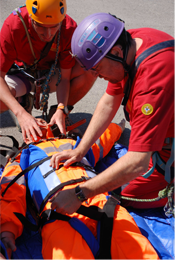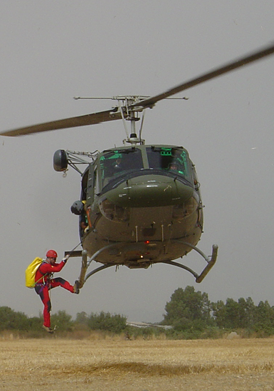You are here: home » activities » prevention
prevention
Prevent hazards
 Prevention, within alpine cliff, high angle and cave rescue, may be defined as a series of actions which aim at avoiding or reducing the risk of, or the likelihood of, undesired events (accidents). Preventing mountain and cave accidents is one of the main tasks of the CNSAS, and this is actuallystated right from the beginning of Law no. 74/2001 and the Statute.
Prevention, within alpine cliff, high angle and cave rescue, may be defined as a series of actions which aim at avoiding or reducing the risk of, or the likelihood of, undesired events (accidents). Preventing mountain and cave accidents is one of the main tasks of the CNSAS, and this is actuallystated right from the beginning of Law no. 74/2001 and the Statute.Mountains and caves, even though they are characterized as "hostile environments", are not dangerous in themselves but may become dangerous if approached without the right training and preparation. Furthermore, it is important to consider that it is impossible to make this type of environment completely safe.
Therefore, the aim of the CNSAS is not to remove dangers completely, but rather to spread prevention awareness enabling those who go to the mountains and caves to assess their own risks accurately. Often, giving up a trip, due to bad weather conditions or inadequate physical preparation, is the best possible prevention method.
The cave rescue team collaborates with speleological groups by organizing courses on the prevention of cave accidents.
In a cave even the smallest injury may become a major accident and require the aid of many rescuers for a long period of time (sometimes several days).
The length of a rescue operation depends not only on the conditions of the injured person, but also on many other factors relating to the cave environment, such as the presence of narrow passages, holes, flooded areas, and on the depth and the distance between the entrance and the place where the accident has taken place.
Advice on how to keep safe in a cave
Be prepared. Get proper training in caving techniques and take part in the activities of speleological groups.
Before going on a cave exploration inform someone you can trust. Give information on: cave position, time of entrance, estimated time of exit and number of people participating.
Never go on your own: the ideal number of people in a team is five, so that two may stay with the injured person, if any, and the other two may go out and call for help.
Always check the weather conditions and forecast in order to avoid the risk of floods.
Always check accurately your personal equipment and the group's equipment.
Assess your own technical preparation and that of your team-mates in proportion to the difficulty of the cave.
Check your own psychological and physical conditions and those of your team-mates.
Weigh your energy in order to save enough energies in case something unexpected occurs.
As soon as you are out of the cave inform the person you had previously told about the time of entrance and exit.
Always have a light on your safety helmet, enabling you to move handsfree; the light must be reliable and long-lasting, which means bringing spare, charged batteries and another emergency light in the event of malfunctioning.
In a cave, in order to avoid getting lost, you need to be careful of the most difficult passages, getting used to turn round regularly so as to find and memorize the way back.
Avoid climbing in caves, unless it is only for very short and easy sections, since holds are usually wet and slippery.
...be prepared, do not ever go alone, check the weather forecasts...






